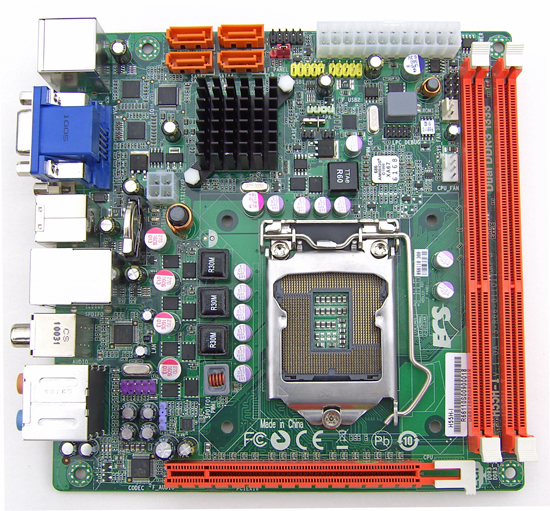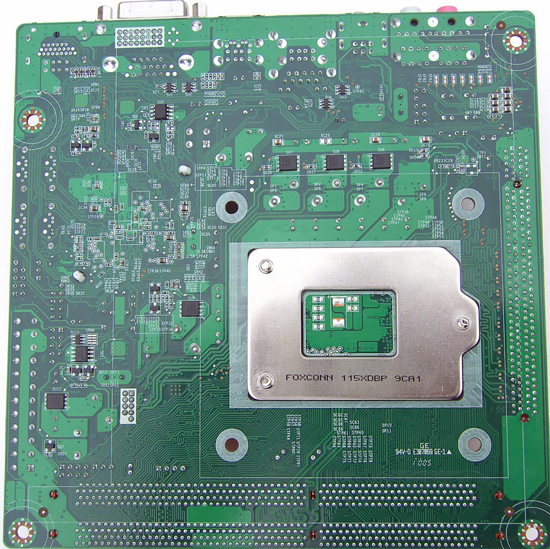ECS H55H-I Review: Mini-ITX at a Sensible Price
by Rajinder Gill on May 6, 2010 6:59 AM EST- Posted in
- Motherboards

The H55H-I follows Intel’s standard H55/H57 mini-ITX layout. CPU socket placement is very close to the PEG slot and the DIMM slots to the right, leaving most tower type coolers out of the equation if using tall DIMMs.
The SATA ports and front panel connecters are placed at the top left of the board along with the CMOS jumper. Given the overclocking options provided and the fact that ECS’ BIOS does not have any kind of safe-boot feature, a rear panel button would have been a better choice.
Power delivery is taken care of by a three phase circuit for VCC, while VTT and VAXG get one phase supplies repectively. We’d guess that all FETs used can pump out around 30 amps each, so not a lot of room for overclocking four core processors.

This is probably the most barren backside we’ve seen on a mini-ITX board to date. There's more than enough room to use coolers with backplates, although we can’t see many people wanting to do that.

Most of what you need is provided on the backplate, the only exception being PS/2 for those of you with older keyboards and mice.










67 Comments
View All Comments
Marlin1975 - Thursday, May 6, 2010 - link
Is Realtek Codec really better than the VIA? I don;t build systems as much as I use to and VIA use to make better Audio Codecs.That and I wish small boards like this would include a built in wireless chip. I know you can use a USB one but the idea of a system like this is small. So to have extra cables and items hanging off it takes away from it. Could be just a very basic one.
Rajinder Gill - Thursday, May 6, 2010 - link
The VIA comment was made in respect of ECS' implementation on the ECS H55H-M that we reviewed a couple of months ago. Same price for the board, but limited Audio out optionshttp://www.anandtech.com/show/2945/2
I should have clarified that better.
Taft12 - Thursday, May 6, 2010 - link
But is it the VIA codec that limits ECS' microATX board to only 3 audio I/O jacks + no SPDIF? Or is that just a matter of ECS not providing the connectors? I'm still not clear.Do any audiophile readers know which is technically superior between VIA and Realtek audio?
mindless1 - Thursday, May 6, 2010 - link
Any modern codec (family, meaning they can make defeatured parts for cost conscious buyers) from Via or Realtek offers 5.1 or more channel output.The issue is not really codec quality, it is board design and PSU selection which determines how much noise gets into the analog circuits. For digital, it's still 1's and 0's.
Point being, roll the dice and take your chances, there are lots of good and bad audio implementations using the very same chips.
For HTPC, what about HDMI audio? Why even bother with onboard analog codec for this purpose?
Rajinder Gill - Thursday, May 6, 2010 - link
From everything I can find, the VT1705 is a 6 channel device, so limited on the analog I/O side. Unfortunately, I can't find a datasheet online so don't know if there are any features ECS chose not to implement. What I will say is that had the features been available I'm sure ECS would have used them. Vendors tend to buy devices like these in bulk, so will utilize them on a wdie range of boards where possible - unless there's a problem.As for arguments about whether or not analogue outputs are needed when HDMI audio is available, this is another area (like the legacy devices) where people have downstream hardware they'd like to use.
Regards
Raja
kake - Saturday, August 21, 2010 - link
One way to get around having an external USB wifi adapter is to use the internal USB header and put the USB adapter inside the case with it. Works a treat.BansheeX - Thursday, May 6, 2010 - link
But the lack of PS2 ports is a con? It's 2010 for cripes sake. If you have a USB mouse and keyboard, then PS2 eats into USB availability. Also detestable is IDE and floppy eating into SATA ports. Being mini-ITX, thank god the board is legacy free, I say.Rajinder Gill - Thursday, May 6, 2010 - link
You're right. I was thinking along the lines of desktop use where people tend to hold on to legacy devices a little too long..IanCutress - Thursday, May 6, 2010 - link
People will upgrade all sorts of things, but you will see those still using a PS2 keyboard and mouse, just because they still work. Also in environments where expensive equipment is used based on old connections (floppy, serial), where it's cheaper to buy a new computer than to buy a new $100k piece of hardware with the newest port, then legacy connectors come into play. It's all very well saying 'thankfully this or that has been removed', but at the end of the day, some people still need them and they're included to widen the market. I have some equipment here in my lab (chemistry) that requires ISA cards; upgrading those computers is always a hassle, trying to find a cheap Core 2 motherboard with ISA ports. Legacy markets are always bigger than you think.Ian
DanNeely - Thursday, May 6, 2010 - link
I'm shocked that you can find one at all. Where are boards like that hiding?